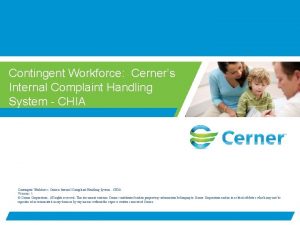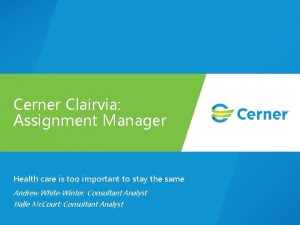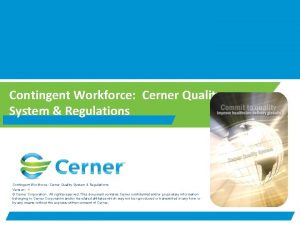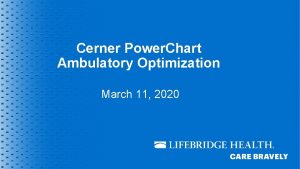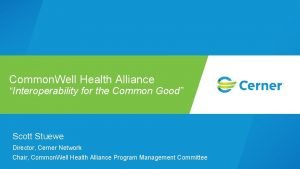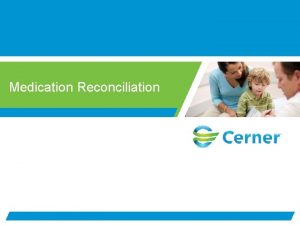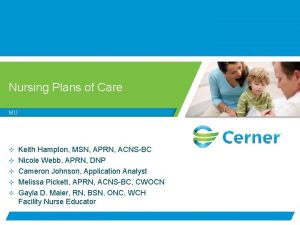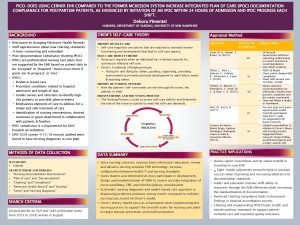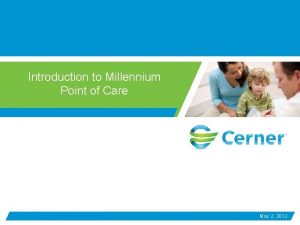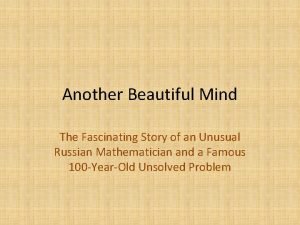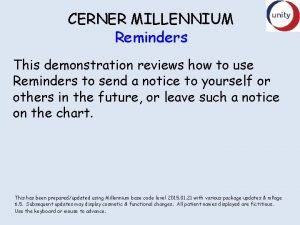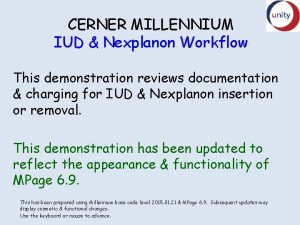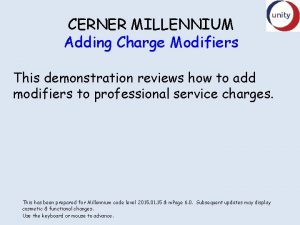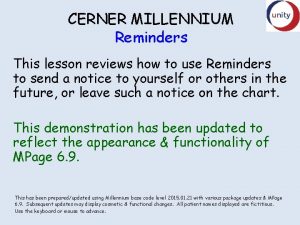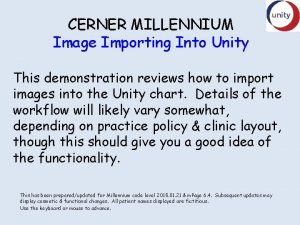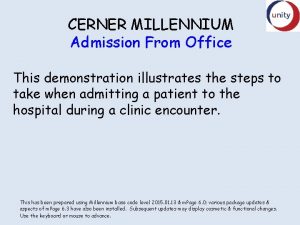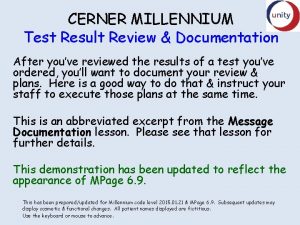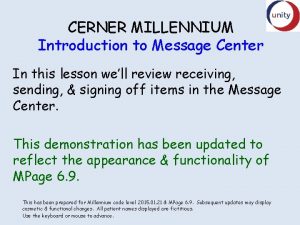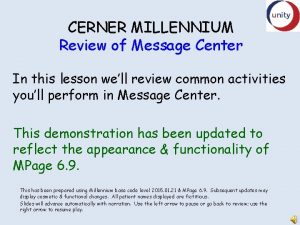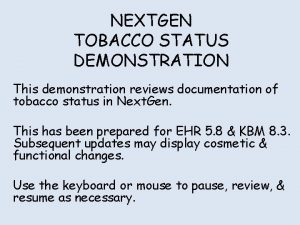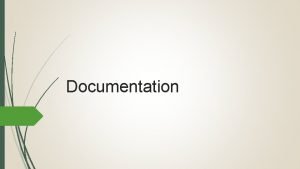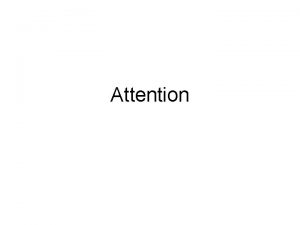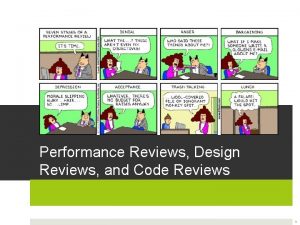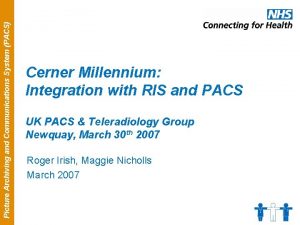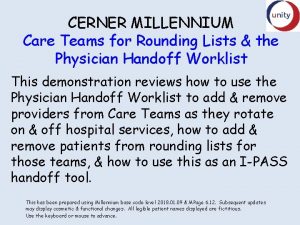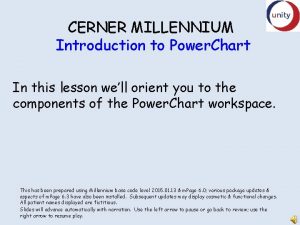CERNER MILLENNIUM Message Documentation This demonstration reviews how

















- Slides: 17

CERNER MILLENNIUM Message Documentation This demonstration reviews how to document a communication, such as a telephone call or message to other USA providers & staff. You can also create brief between-visit clinical notes in this fashion. This demonstration has been updated to reflect the appearance & functionality of MPage 6. 9. This has been prepared/updated for Millennium code level 2015. 01. 21 & MPage 6. 9. Subsequent updates may display cosmetic & functional changes. All patient names displayed are fictitious. Use the keyboard or mouse to advance.

Users will often need to document communications or other between-encounter notes about a patient—e. g. , notes about a telephone call to a patient, or a brief note to another USA provider or staff member. To begin, if you don’t already have the patient’s chart open, search for the patient by typing name or MRN into the search box.

Further refine your search if necessary, then hit Enter or click Search.

Click on the desired patient at the top, & you’ll see a list of encounters at the bottom. Look for the latest Encounter Type of “Clinic” at your Location. If you see an encounter labeled AAA Message, don’t use that; this was an earlier approach to between-visit message documentation that we have since abandoned.

When there is a long list of encounters, it can be helpful to sort by your Location. Click on the Location column heading, then scroll to your location. Look at the Enc Type column, & double click the latest Clinic encounter you see. Sometimes this Clinic encounter will be an actual previous visit, & sometimes it might be a placeholder Clinic encounter for messaging & test-ordering purposes. If you don’t see one dated after our 10/1/17 Unity Go Live date, ask your staff to create one.

If you don’t already have an established relationship with the patient, select one. (Different users may see different options. ) The chart opens.

On the toolbar, click the Communicate button. The dropdown arrow on the right lets you choose to go directly into a few options, like message, reminder, or letter. For this example, select Message.

The New Message window opens. There are several intuitive options here, which we’ll briefly review. For starters, notice that if you hadn’t already selected the patient, you could perform the patient search from here.

If you’re just leaving a note on the chart, leave the To field blank. If you’re communicating with another provider or staff member, or you just want to call the note to the attention of someone else, search for that user. Type at least part of the name & click the binoculars button.

Complete your search. Select the desired recipient, then click Add to move into the Send to box on the right. You can select multiple recipients, or a user pool. When done, click OK.

Clicking Include me sends a copy to yourself, e. g. , to make this a reminder to yourself. You can also CC others. Change the Subject line if desired. If this is intended to be a note on the chart, click Save to Chart. It will appear on documentation lists, just like encounter notes. If it is just a communication to another user you don’t want saved to chart, leave this unchecked. If you wish, you can also click the As dropdown list to select how it will be categorized.

Enter your message; you can type, use Auto. Text, or Dragon voice recognition. You have access to font formatting tools as desired. There are Actions checkboxes that may sometimes be handy.

If Due date is germane, you can select that; otherwise just leave it blank. (Remind on doesn’t really do anything of significance. ) When done, click Send.

Notes like this usually don’t appear on the Documents list you’ll see on a workflow tab (AKA MPage). To see them, click Documentation on the Table of Contents.

Click on the note to review it. The Notes item on the Table of Contents provides similar functionality.

You can also see it under your Sent Items in Message Center.

Note that sending in a prescription or ordering a test is a common activity as a result of an after-hours or betweenvisit patient contact. You can perform these activities on the latest Clinic encounter as well. The important thing to remember is to do it on a Clinic encounter at your location. This assures that all of these orders route properly. Just don’t place charges on an encounter other than the one where you actually saw the patient.
 Cisi wallin
Cisi wallin Workforce cerner
Workforce cerner Cerner clairvia
Cerner clairvia Northland caps
Northland caps Cerner smart templates
Cerner smart templates Workforce.cerner
Workforce.cerner Cerner ambulatory organizer
Cerner ambulatory organizer Kathleen fisher cerner
Kathleen fisher cerner Cssr-s risk assessment
Cssr-s risk assessment Cerner icons
Cerner icons Cerner ipoc
Cerner ipoc Cerner ipoc
Cerner ipoc Cerner junefordbloomberg
Cerner junefordbloomberg Cerner care compass
Cerner care compass Millennium prize problems
Millennium prize problems Millennium scholars program
Millennium scholars program Millennium goals 2000
Millennium goals 2000 Us digital millennium copyright act curious
Us digital millennium copyright act curious

